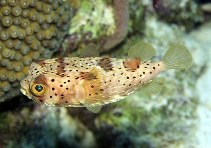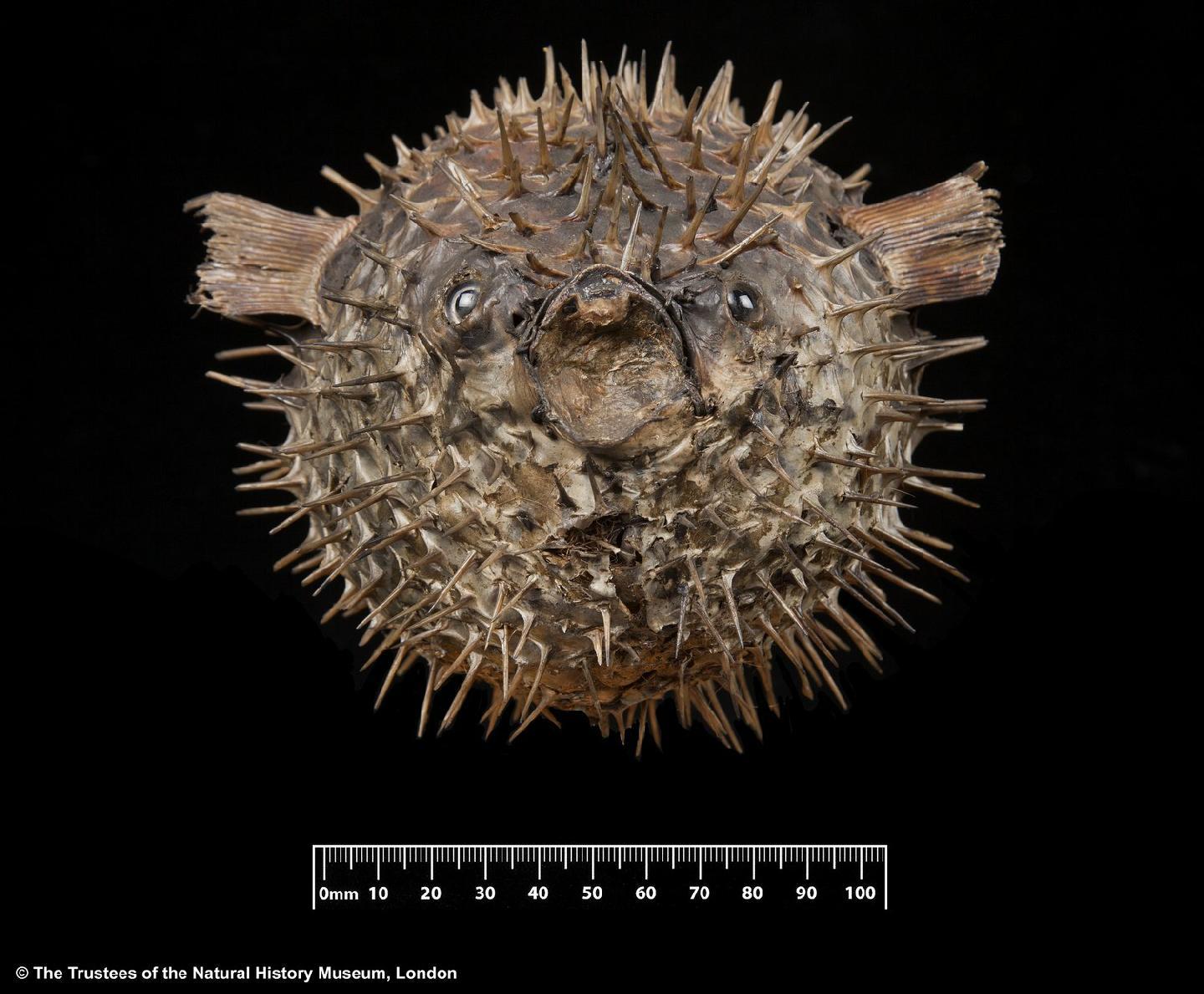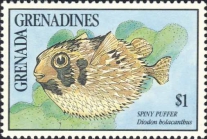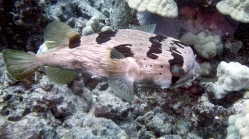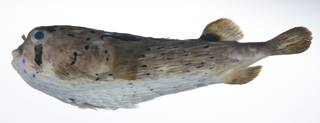
| Introduction | | Search taxa | | Taxon tree | | Taxon match | | Checklist | | Literature | | Stats | | Photogallery | | OBIS Vocab | | Log in |
CaRMS taxon detailsDiodon holocanthus Linnaeus, 1758
127402 (urn:lsid:marinespecies.org:taxname:127402)
accepted
Species
marine,
Linnaeus, C. (1758). Systema Naturae per regna tria naturae, secundum classes, ordines, genera, species, cum characteribus, differentiis, synonymis, locis. <em>Editio decima, reformata [10th revised edition], vol. 1: 824 pp. Laurentius Salvius: Holmiae.</em> , available online at https://biodiversitylibrary.org/page/726886 [details] Available for editors
Description Inhabits shallow reefs to open, soft bottoms to at least 100 m . Also in areas with rocky substrata. Sometimes forms groups...
Description Inhabits shallow reefs to open, soft bottoms to at least 100 m . Also in areas with rocky substrata. Sometimes forms groups (Ref. 9710). Juveniles pelagic to about 6-9 cm. Solitary. Feeds on molluscs, sea urchins, hermit crabs and crabs at night (Ref. 9680). A relatively poor swimmer (Ref. 9710). [details] Distribution circumtropical in distribution; Western Atlantic: Near Georges Bank to Brazil
Distribution circumtropical in distribution; Western Atlantic: Near Georges Bank to Brazil [details]
Froese, R. and D. Pauly. Editors. (2024). FishBase. Diodon holocanthus Linnaeus, 1758. Accessed through: Nozères, C., Kennedy, M.K. (Eds.) (2024) Canadian Register of Marine Species at: https://marinespecies.org/carms/aphia.php?p=taxdetails&id=127402 on 2024-04-18
Nozères, C., Kennedy, M.K. (Eds.) (2024). Canadian Register of Marine Species. Diodon holocanthus Linnaeus, 1758. Accessed at: https://marinespecies.org/carms/aphia.php?p=taxdetails&id=127402 on 2024-04-18
Date action by
original description
Linnaeus, C. (1758). Systema Naturae per regna tria naturae, secundum classes, ordines, genera, species, cum characteribus, differentiis, synonymis, locis. <em>Editio decima, reformata [10th revised edition], vol. 1: 824 pp. Laurentius Salvius: Holmiae.</em> , available online at https://biodiversitylibrary.org/page/726886 [details] Available for editors
context source (HKRMS) Hong Kong marine fish database. <em>AFCD.</em> , available online at https://www.hk-fish.net/en/fish/introduction/ [details] context source (Bermuda) Smith-Vaniz, W. F.; Collette, B. B.; Luckhurst, B. E (1999). Fishes of Bermuda: History, zoogeography, annotated checklist, and identification keys (American Society of Ichthyologists and Herpetologists - Special Publication No.4) . ASIH, 424 pp. [details] context source (PeRMS) Chirichigno, N.; Cornejo, M. (2001). Catálogo comentado de los peces marinos del Perú. <em>2ª ed. Instituto del Mar de Perú. Publicación Especial. Callao.</em> 314 p. [details] basis of record van der Land, J.; Costello, M.J.; Zavodnik, D.; Santos, R.S.; Porteiro, F.M.; Bailly, N.; Eschmeyer, W.N.; Froese, R. (2001). Pisces, <B><I>in</I></B>: Costello, M.J. <i>et al.</i> (Ed.) (2001). <i>European register of marine species: a check-list of the marine species in Europe and a bibliography of guides to their identification. Collection Patrimoines Naturels,</i> 50: pp. 357-374 (look up in IMIS) [details] additional source Gulf of Maine Biogeographic Information System (GMBIS) Electronic Atlas. 2002. November, 2002. [details] additional source McEachran, J. D. (2009). Fishes (Vertebrata: Pisces) of the Gulf of Mexico, Pp. 1223–1316 in: Felder, D.L. and D.K. Camp (eds.), Gulf of Mexico–Origins, Waters, and Biota. Biodiversity. Texas A&M Press, College Station, Texas. [details] additional source Liu, J.Y. [Ruiyu] (ed.). (2008). Checklist of marine biota of China seas. <em>China Science Press.</em> 1267 pp. (look up in IMIS) [details] Available for editors additional source Froese, R. & D. Pauly (Editors). (2023). FishBase. World Wide Web electronic publication. version (02/2023)., available online at https://www.fishbase.org [details] ecology source Looby, A.; Erbe, C.; Bravo, S.; Cox, K.; Davies, H. L.; Di Iorio, L.; Jézéquel, Y.; Juanes, F.; Martin, C. W.; Mooney, T. A.; Radford, C.; Reynolds, L. K.; Rice, A. N.; Riera, A.; Rountree, R.; Spriel, B.; Stanley, J.; Vela, S.; Parsons, M. J. G. (2023). Global inventory of species categorized by known underwater sonifery. <em>Scientific Data.</em> 10(1). (look up in IMIS), available online at https://doi.org/10.1038/s41597-023-02745-4 [details]  Present Present  Inaccurate Inaccurate  Introduced: alien Introduced: alien  Containing type locality Containing type locality
From other sources
Description Inhabits shallow reefs to open, soft bottoms to at least 100 m . Also in areas with rocky substrata. Sometimes forms groups (Ref. 9710). Juveniles pelagic to about 6-9 cm. Solitary. Feeds on molluscs, sea urchins, hermit crabs and crabs at night (Ref. 9680). A relatively poor swimmer (Ref. 9710). [details]Diet Feeds on mollusks, sea urchins, hermit crabs, and crabs at night [details] Distribution circumtropical in distribution; Western Atlantic: Near Georges Bank to Brazil [details] Habitat Inhabits shallow reefs to open, soft bottoms. Also in areas with rocky substrata. Sometimes forms groups. [details] Habitat benthic [details] Habitat Known from seamounts and knolls [details] Importance Scientific- used in Chinese medicine [details]
To Barcode of Life (166 barcodes)
To Biodiversity Heritage Library (42 publications) To Biological Information System for Marine Life (BISMaL) To European Nucleotide Archive (ENA) To FishBase To FishBase images (Diodon holocanthus, Neth Antilles, by Patzner, R.) To GenBank (296 nucleotides; 239 proteins) To Global Biotic Interactions (GloBI) To IUCN Red List (Least Concern) To NHMUK collection (Diodon holocanthus Linnaeus, 1758; HOLOTYPE; NHMUK:ecatalogue:2527161) To NMNH Extant Collection (Diodon holocanthus USNM 408916 photograph dorsal view) To PESI To ITIS |
